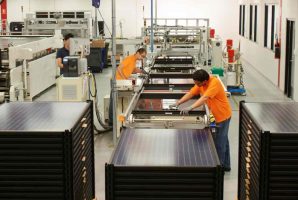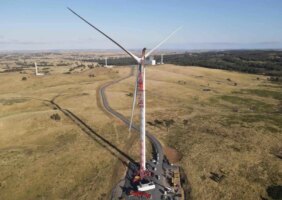A relatively peaceful and event-free summer on South Australia’s electricity grid came to an abrupt end over the weekend, as a combination of maintenance work on the main transmission line, a fire in a key transmission station and then extremely low demand sent prices soaring to the market cap on Friday night, and then to below zero for much of the weekend.
One of the two main circuits on the main transmission line that connects South Australia to Victoria and the rest of the main grid was closed on Friday afternoon as part of long planned maintenance to complete repairs from more than a year ago when a storm blow down some huge transmission towers.
The South Australia grid then faced an unexpected challenge later on Friday when a cable fire in the switchyard at the transmission station at Torrens Island caused the new 210MW Barker’s Inlet peaking gas plant to trip, and also took out the main units at the 1,280MW Torrens Island, the state’s biggest gas generator.
This happened just as the sun was setting and rooftop solar and large scale solar power were winding down. So, with little wind energy being generated at the time, and more than half the state’s gas capacity sidelined by the fire, prices soared to the market cap of $15,000/MWh as diesel generators fired up to fill the gap.
That sent the average price for Friday to an astonishing $1,335/MWh, according to AEMO data, compared to the state’s average in calendar 2021 of just $36/MWh. But on Saturday and Sunday, the situation was nearly reversed, with prices mostly negative (they averaged minus $48/MWh and minus $158/MWh on Saturday and Sunday respectively) because of the constraints on the grid caused by the maintenance work.

The constraints meant that exports were limited, and excess wind and solar couldn’t find a ready market. The state’s three big solar farms – and some of the big wind farms too – barely operated on Saturday and Sunday, despite fine solar conditions, because of the negative prices and the lack of demand, which was being soaked up mostly by rooftop solar.
Grid demand threatened to fall so low that on Sunday morning AEMO warned that there may be “insufficient forecast scheduled demand to maintain a secure operating state” in South Australia. Because most of the power supply was being met by rooftop solar, AEMO predicted that “minimum scheduled demand” could be as low as 372MW in the afternoon.
This is below its threshold of 400MW when AEMO deems the local grid is at risk of “islanding” – due to the transmission works – and meant it might need to direct a thermal generator to switch on despite the negative prices, and potentially force wind and distributed solar PV out of the system.
In the end, grid demand fell lower than predicted. At 2.30pm grid time (grid time operates on AEST, same as Queensland) grid demand fell to 358MW – not quite a record low, it hit 300MW last spring – but low enough to force AEMO to take action.
However, rather than force feed another gas generator into the system, AEMO chose instead to “constrain”, or switch off, enough rooftop solar capacity to ensure demand returned to more comfortable levels.
It did this by instructing ElectraNEt to switch off – for about one our – around 67MW of solar PV out of the around 1,000MW that was generating at the time. That’s not a big percentage, just 7 per cent, but it is significant step as it is a sign of the future, when solar PV constraints and curtailments will likely become common, and more widespread, as their share of generation continues to increase.
Indeed, AEMO now requires that new rooftop solar systems in South Australia have the capacity to be “switched off” – this is done through via inverter settings and by nominating an “agent” who can control the output – and it will have more than 100MW available for such needs by next spring.
Indeed, on Sunday, some 10MW of distributed solar PV was curtailed through this “Smarter Homes” initiative, deployed for the first time, around 40 MW of rooftop solar PV was curtailed through enhanced voltage management at seven substations, and another 17 MW of commercial solar PV was curtailed through SCADA control systems.
AEMO says that the events of the weekend also underline the case for “orchestration” of distributed solar, the need for more storage – both battery and pumped hydro – and the new Project EnergyConnect transmission link to NSW, which is being held up by the slow and exhausting regulatory process, particularly after a blow out in costs to $2.4 billion.
Critics complain that the regulatory process is too focused on narrow economic outcomes rather than broader benefits. The energy ministers of South Australia and NSW recently joined AEMO in pointing out to the regulator the obvious benefits of having the new link. The weekend’s events reinforce that position.
“AEMO has been working with Governments and market bodies to support the development of a range of measures, including ways of load shifting and shaping, to continue to facilitate greater amounts of renewable energy in the network and maximising consumer benefits,” an AEMO spokesman said.
“AEMO has been working with Governments and market bodies to support the development of a range of measures to continue to facilitate greater amounts of renewable energy in the network and maximising consumer benefits.
“Minimum demand events will become increasingly common throughout Australia as we continue to integrate rooftop PV installations.
“It is also vital the ESB’s post 2025 energy reforms continue to progress to enable modern regulatory and market responses to these situations.”










